Newark Penn Station
Producing ‘interstitial’ atmospheres in a hegemonic reality
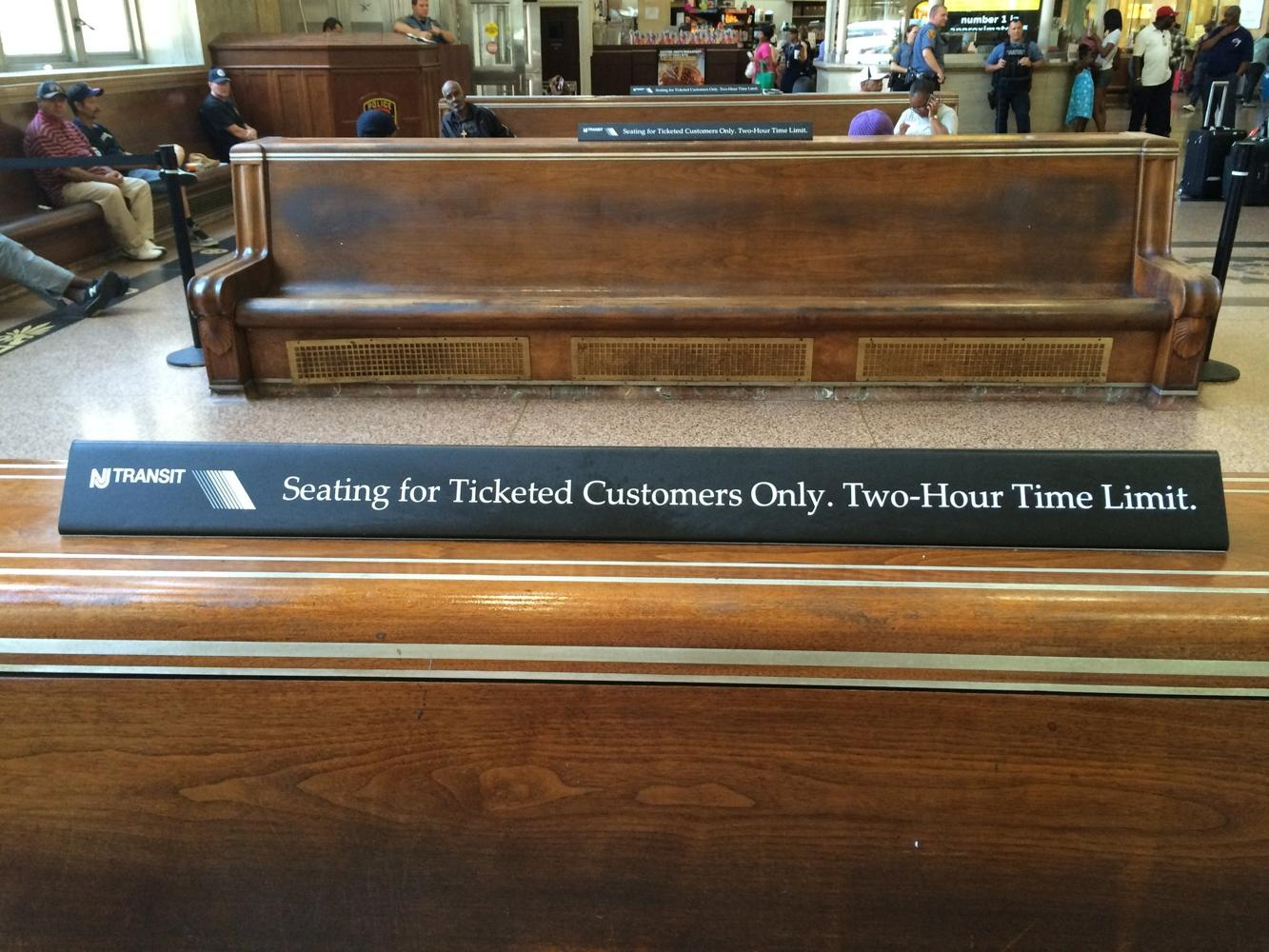
warning sign on the
benches in the NJ’s waiting hall
Since 2019, Newark
Penn Station has been undergoing a ‘modernization process’ funded mainly by the
State of New Jersey and NJ Transit. The indoor spaces of the station have been
filled with warning signs, directive panels, hostile architectures, and physical
thresholds, pushing those who experience the space to act as appropriate
‘paying passengers.’ These spatial elements dictate which behaviors are
accepted as ‘appropriate’ in the environment, and they also identify specific
spaces that are physically barred to subjectivities who differ from the ‘proper
passenger.’
![]()
![]()
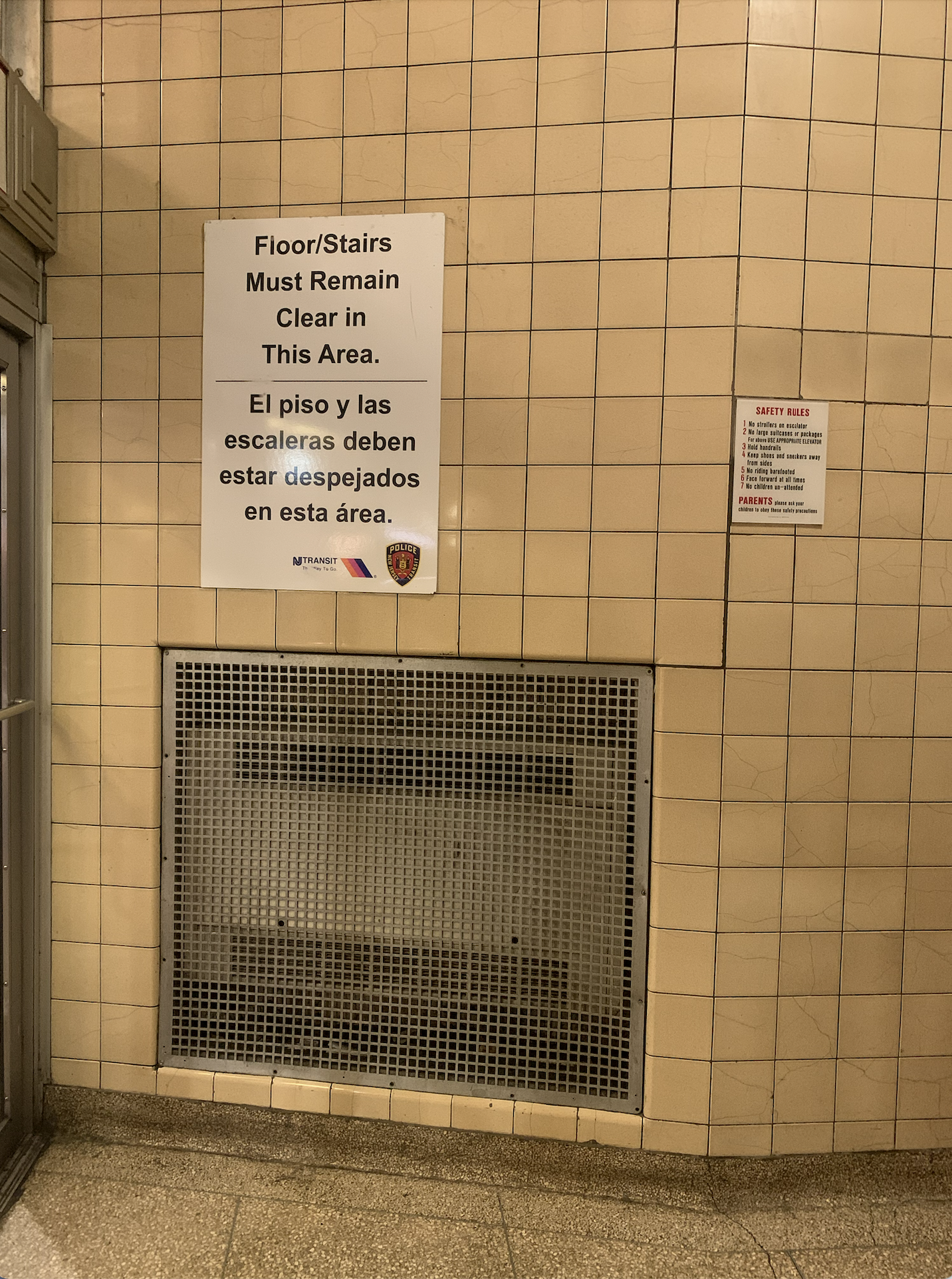

warning sign in the
stairway leading from the main hall to Track #1
The modernization of
Penn Station, an iconic and elegant landmark in Newark’s cityscape, is part of
the latest phase of urban revitalization, re-branding, and gentrification that
began in the 1990s. From an urban planning perspective, it could be argued that
Penn Station has become a ‘mobility environment,’ namely a place where “mobility
flows interconnect – such as [in] airports, railway stations, and also motorway
service areas or urban squares and parks – [and] have the potential for
granting the diversity and frequency of human contacts that are still essential
for many urban activities” (1). Thousands of passengers utilize Penn Station’s mobility
infrastructures daily, from the PATH and Northeast Corridor trains to the
Newark Light Rail’s two lines.
The station’s visible
cleanliness and perceived safety are maintained largely through the presence of
the aforementioned structural thresholds and signage, as well as by armed
policemen and private guards patrolling the station at all times. This well-disciplined
atmosphere is juxtaposed to the unruliness of the living city surrounding the station,
exemplified metaphorically by the architectural features of the Gateway Center,
a complex of four buildings located just outside of the station. Connected to
Penn Station through a system of sky-bridges spanning Raymond Boulevard and
McCarter Highway, the Gateway buildings make it possible for pedestrians to enter
the buildings without ever having to set foot onto the streets of the city.
On a larger scale, the infrastructural networks converging at, and radiating from, Newark Penn Station allow paying passengers to reach discrete locations around the city without having to experience the city itself: i.e. the city as an entity suffering from decades of neglect, lack of investment, and marginalization based on infamous narratives about its urban dangers. Beginning with the (failed) urban renewal plans of the 1950s, Newark has increasingly assumed the shape of a fragmented, low-income, and exclusionary teleport city: an urban configuration in which infrastructural networks selectively connect visitors and city-users to ‘worthy’ places while ignoring the ‘useless’ and dilapidated parts of the living, breathing city (2).
On a larger scale, the infrastructural networks converging at, and radiating from, Newark Penn Station allow paying passengers to reach discrete locations around the city without having to experience the city itself: i.e. the city as an entity suffering from decades of neglect, lack of investment, and marginalization based on infamous narratives about its urban dangers. Beginning with the (failed) urban renewal plans of the 1950s, Newark has increasingly assumed the shape of a fragmented, low-income, and exclusionary teleport city: an urban configuration in which infrastructural networks selectively connect visitors and city-users to ‘worthy’ places while ignoring the ‘useless’ and dilapidated parts of the living, breathing city (2).
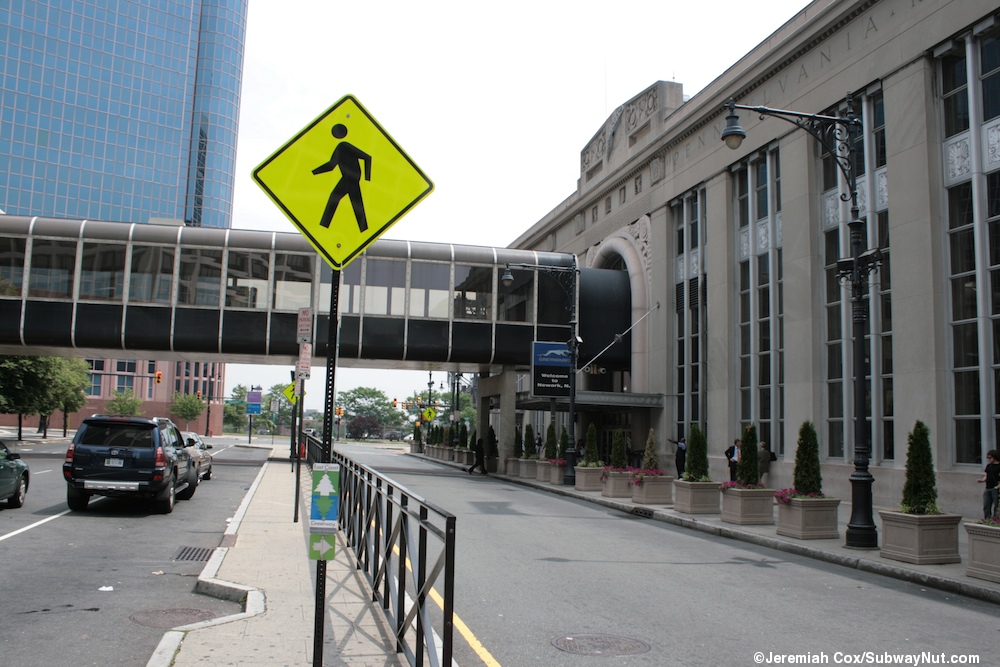
sky-bridge
between Penn Station and the Gateway buildings
Within this system,
Newark Penn Station functions as the central hub, the ‘door’ of a city
that is competing fiercely to regain a spot on the map of American history. To
accommodate the expectations of commuters ‘teleporting’ into the uncoupled city (3), the station instrumentalizes sensory experiences, beyond the signage
and security patrols, to enhance the feeling of orderliness and regulation.
Among the most potent techniques for producing Penn Station’s atmosphere as a
‘safety sanctuary’ is the use of smell: with the expansion of the commercial
area on the ground floor, the area is now permeated with the myriad, pleasant
smells of coffee, donuts, pizza, popcorn, flowers, and candies. The popcorn
smell in particular suffuses the ground level with a familiar, reassuring
aroma. These scents stand in jarring juxtaposition to the strong stink of
urination, litter, and burned diesel that overpower the platforms on the
station’s second floor and the outdoor areas immediately surrounding it.

warning sign positioned just outside the popcorn shop
The distasteful
smells act metaphorically to brand the people occupying those outer areas as
‘undesirable’ as well. The primary target of the station’s politics of control,
expressed through its signs and guard patrols, is the unhoused population
inhabiting the station’s outdoor spaces. During the night, dozens of people
create makeshift, precarious shelters at interstitial spots just outside of the
station, in particular under the bridges where the bus stops are located. In
daytime, especially in the early morning, it is not uncommon for passengers to
come across people inside the station holding sleeping bags or having breakfast
at the ledges that ring the station’s large hall. These transients are not
allowed to sit anywhere, but have to stand even while eating: the policemen and
the signs are designed precisely to remind them that “seating is only permitted
in designated areas” (meaning for passengers) and that the “stairs must remain
clear.” Penn Station’s indoor spaces are thus not amenable to those who did not
buy a ticket or a fast meal to be consumed while waiting for a train; the station’s
spaces are designed to be cleared of ‘unwanted’ presences as soon as their meal
is done.
![]()
![]()
checkpoint at the entrance of the NJT waiting hall windowsill with hostile architecture
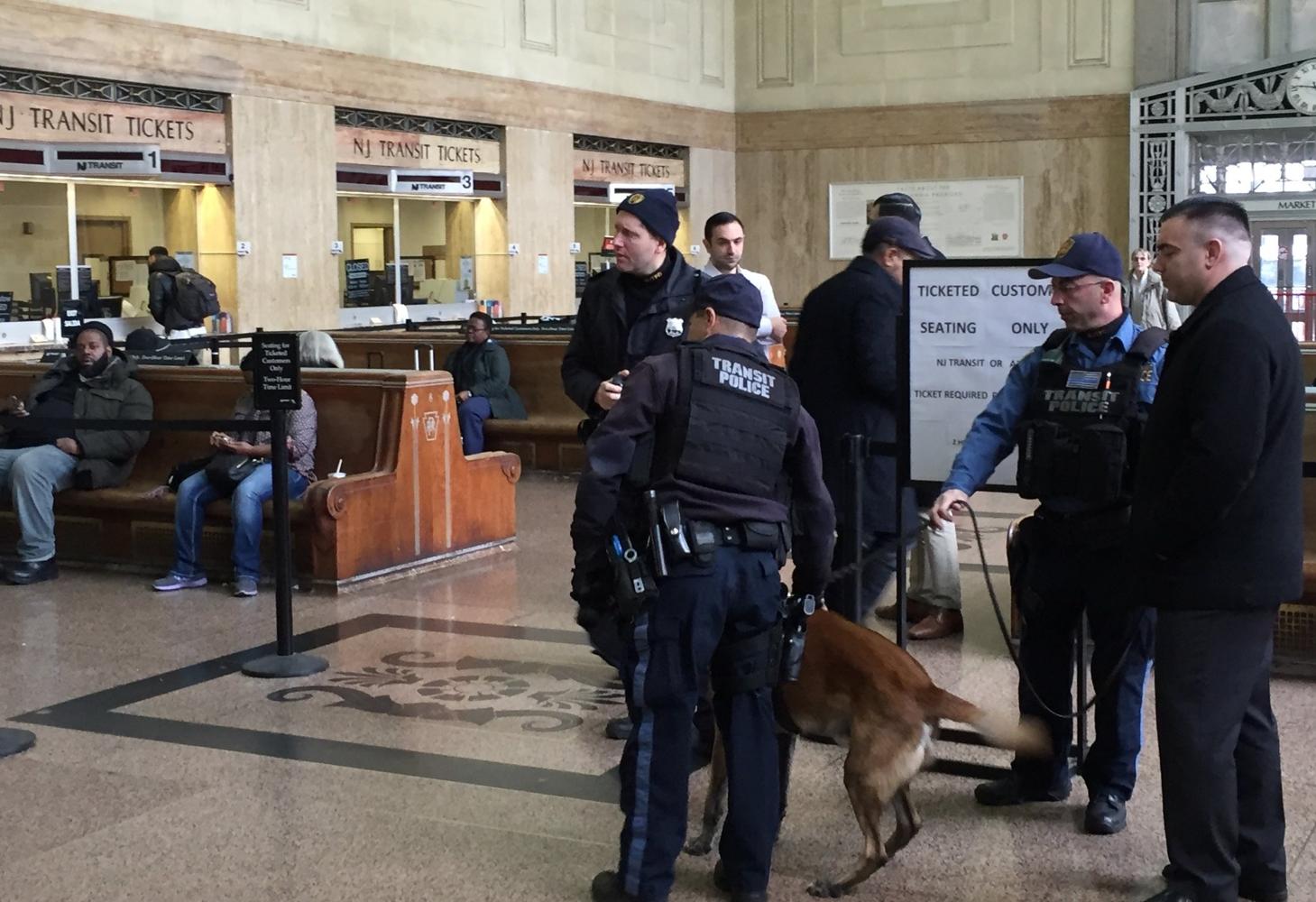

checkpoint at the entrance of the NJT waiting hall windowsill with hostile architecture
Other subjectivities,
however, have managed to turn the station’s exclusionary, controlling atmosphere
of “safety” and “cleanliness” upside down, subverting and rewriting its normative
behavioral expectations. Starting in the 1960s, for instance, Penn Station became
one of the most important and safest spaces for gay cruising and sociability in
Newark, at a time when gay men were otherwise excluded from open participation
in the public sphere. In interviews conducted by the Queer Newark Oral History
Project, several members of the LGBTQ+ community recall that the ‘gentlemen’s
bathroom’ located on the station’s ground floor functioned historically as a
place where gay men could experience their sexuality without any particular
danger (4). Today, users of websites that review and rate gay cruising spots in
Newark still describe Penn Station as one of the best spots for sexual interactions
in the city. Some users also utilize the websites’ comments section as a platform
to date other men looking for casual encounters. Tellingly, an anonymous content-creator
on a famous adult-video streaming website recently uploaded amatorial videos of
his sexual encounters in Penn Station, turning it into the main stage of his pornographic
video production.
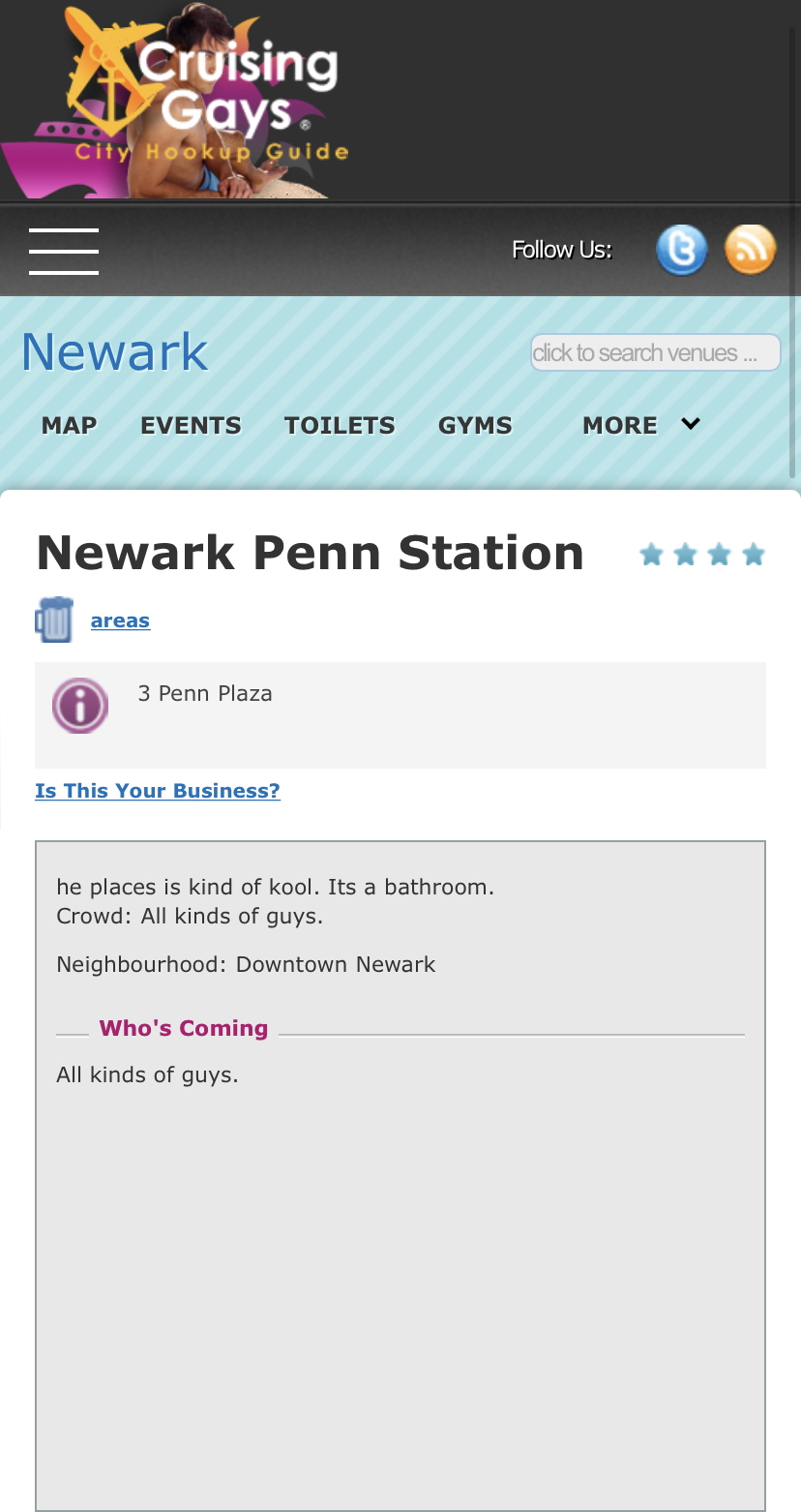
website on which users can
rate cruising spots in Newark
As the experiences of
gay men in Newark demonstrate, hegemonic and normative urban atmospheres can be
challenged and redressed. In that particular example, the reappropriation of
space was effected by distorting and working through the ‘grammars of power’
that otherwise sustain the spatial language imposed on and throughPenn Station. This reinterpretation and reclamation of space relies on practices
that construct interstitial atmospheres within both the material and poetic functions
of the station’s spaces. Such atmospheric enclaves exist within the contradictions
that emerge from the interplay between the exclusive, unjust models of urban
development implemented in Newark and the needs and silenced claims of the excluded
communities living in the city. These practices can be interpreted as an example
of what the philosopher Leo Strauss describes as the literary techniques of ‘writing
between the lines’ (5). They may not represent explicit or loud calls for
freedom, resistance, or emancipation, but they are still able to produce
silent, ‘heterodox’ atmospheres below the hegemonic surface of reality, which can
be experienced by those who share the means – and the need – to interpret and
understand them (5).
1. Bertolini, L. and M. Dijst. (2010). “Mobility environments and network cities.” Journal of Urban Design 8 (1), 27-43, quote on 28.
2. Alioni, M. (2023). Gravitational Geometries of Exclusion: Infrastructuring (In)justice in Brescia (Italy) and Newark (New Jersey, USA). Ph.D. dissertation - Politecnico di Torino (Turin, Italy).
3. A. Mallach (2015). “The uncoupling of the ‘Economic City’: Increasing spatial and economic polarization in American older industrial cities.” Urban Affairs Review 51 (4), 443-473.
4. Queer Newark Oral History Project. Interviews can be found at: https://queer.newark.rutgers.edu/
5. Strauss, L. (1952). Persecution and the Art of Writing. Free Press.
1. Bertolini, L. and M. Dijst. (2010). “Mobility environments and network cities.” Journal of Urban Design 8 (1), 27-43, quote on 28.
2. Alioni, M. (2023). Gravitational Geometries of Exclusion: Infrastructuring (In)justice in Brescia (Italy) and Newark (New Jersey, USA). Ph.D. dissertation - Politecnico di Torino (Turin, Italy).
3. A. Mallach (2015). “The uncoupling of the ‘Economic City’: Increasing spatial and economic polarization in American older industrial cities.” Urban Affairs Review 51 (4), 443-473.
4. Queer Newark Oral History Project. Interviews can be found at: https://queer.newark.rutgers.edu/
5. Strauss, L. (1952). Persecution and the Art of Writing. Free Press.
Picture credits, in order of appearance:
1. https://www.nj.com/traffic/2017/02/constitutionality_of_nj_transits_new_waiting_room_ban_questioned.html
2. photo and closeup: picture taken by the author
3. https://subwaynut.com/njt/newark_penn/newark_penn14.jpg
4. picture taken by the author
5. https://www.nj.com/traffic/2017/02/constitutionality_of_nj_transits_new_waiting_room_ban_questioned.html
6. picture taken by the author
1. https://www.nj.com/traffic/2017/02/constitutionality_of_nj_transits_new_waiting_room_ban_questioned.html
2. photo and closeup: picture taken by the author
3. https://subwaynut.com/njt/newark_penn/newark_penn14.jpg
4. picture taken by the author
5. https://www.nj.com/traffic/2017/02/constitutionality_of_nj_transits_new_waiting_room_ban_questioned.html
6. picture taken by the author
Mapmaker: Marco Alioni
Posted 5/2/2023
Posted 5/2/2023